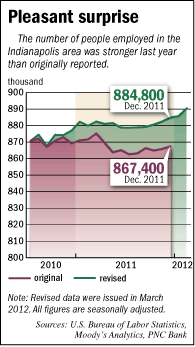Subscriber Benefit
As a subscriber you can listen to articles at work, in the car, or while you work out. Subscribe NowTurns out things weren’t quite as bad as we thought.
 The Indianapolis-area economy had 13,000 to 17,000 more jobs than the U.S. Bureau of Labor Statistics reported last summer—when the entire nation’s economy sputtered. The metro area then ended the year on a strong upswing that has only accelerated in 2012.
The Indianapolis-area economy had 13,000 to 17,000 more jobs than the U.S. Bureau of Labor Statistics reported last summer—when the entire nation’s economy sputtered. The metro area then ended the year on a strong upswing that has only accelerated in 2012.
That’s not to say everything is great in the Circle City. The region still has 30,000 fewer jobs than it did before the recession began in December 2007. And wages have not kept pace with inflation.
But the higher jobs numbers mean economic optimists are singing a little louder now.
“It doesn’t surprise me at all,” said Gary Hentschel, president of the central Indiana district for Cleveland-based Key Bank. He added, “For two years, I’ve been optimistic, and now I’m feeling even better.”
Hentschel said Key’s corporate clients have generated increasing loan demand for two years. And now in recent months, Key has seen its consumers request more auto and home equity loans.
In February, 890,000 people were employed in Indianapolis and its adjacent counties, according to the Bureau of Labor Statistics. That’s up 6,000 since December, but it’s 23,000 more than the BLS originally reported for December.
The federal agency issued a massive revision of data in March, as it does every year. But the changes for 2011 data were particularly large.
That was because the BLS started using slightly different factors for how it adjusts the survey data to account for seasonal variations in employment—such as retailers’ mass hiring during the Christmas season. Its changes affect all data back to January 2007 and some data as far back as 1990.
Kurt Rankin, an economist at PNC Bank in Pittsburgh, also sees reasons for optimism, but he said the extra jobs don’t fix Indianapolis’ biggest challenge: stagnant wages and income.
Average weekly wages in the Indianapolis area grew just 1 percent in each of the past two years, according to BLS data. But inflation in Midwestern cities during those two years rose 2 percent and 3.2 percent, respectively, leaving Hoosiers with less purchasing power.
“Even though jobs are coming back, they’re coming back in private-sector business services, and leisure and hospitality. But these aren’t at the same pay levels, of course, as the jobs that were lost,” said Rankin, who follows the Indianapolis economy for PNC.
Indeed, good-paying manufacturing jobs in the Indianapolis area were at the same level as in January 2011—about 80,000—and still off 18 percent since the start of the recession in December 2007.
Until the disruption from last year’s earthquake in Japan—which interrupted supply lines for the Subaru plant in Lafayette, the Honda plant in Greensburg, and the Toyota plant in Princeton—manufacturing in Indiana was having a great recovery.
The pace of national auto sales in March hit a four-year high, which signals that sector is picking up steam again.
Rankin says Indianapolis’ big employers—including Eli Lilly and Co., Roche Diagnostics Corp., FedEx and JP Morgan Chase & Co.—will have to start hiring more in order to meaningfully boost incomes in the Indianapolis area.
He expects that to start happening by roughly the middle of 2012.
Meanwhile, some smaller operations have been expanding and hiring. Indianapolis-based Applied Composites Engineering, which makes composite parts for aerospace manufacturers, acquired a 30,000-square-foot building in the middle of last year and is slowly building it out to accommodate new orders it expects to receive.
The company has tripled its work force over the last five years, to 111, including adding eight people in 2012 already.
Dave Shaw, Applied Composite’s vice president of human resources, said his company still gets flooded with applications for some jobs—such as the more than 100 he received recently for a finance position—but is also starting to see more employers competing for certain workers.
Shaw has received only three applications for a designated engineering representative opening she posted three months ago.
“It’s fairly competitive, I feel like in this market,” Shaw said of finding talented workers. “It’s becoming more and more competitive, for sure.”
Shaw’s observations may help explain why average weekly wages have been up 2 percent to 3 percent in January and February. That’s what Key Bank’s Hentschel suspects is occurring.
“As we look back on 2012 a year from now, we’ll see that it was happening,” he said. “It’s coming.”•
Please enable JavaScript to view this content.
